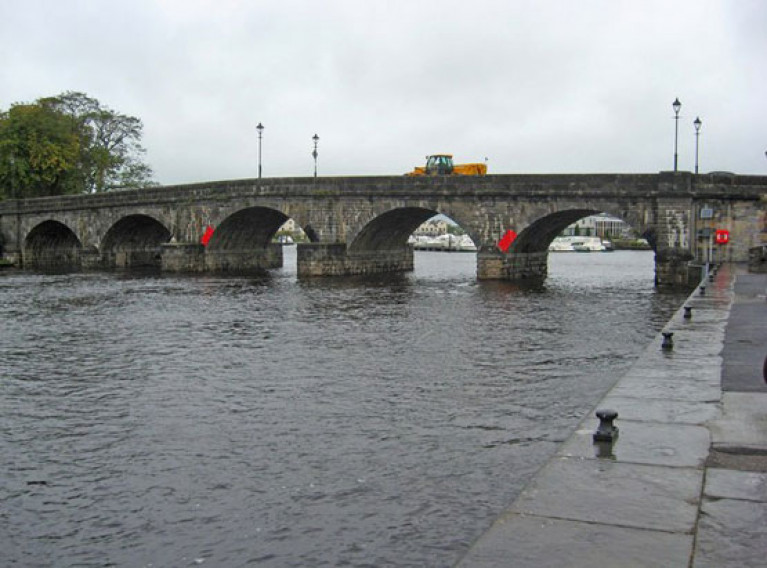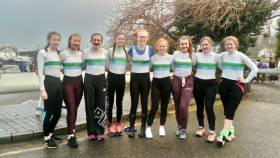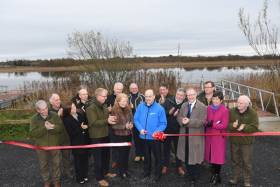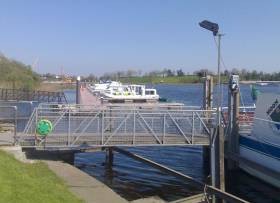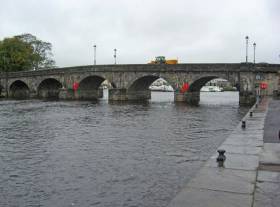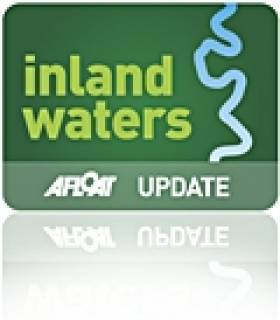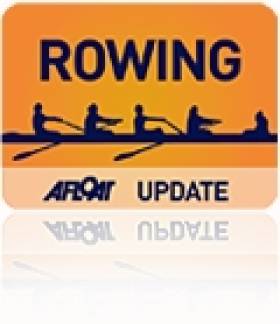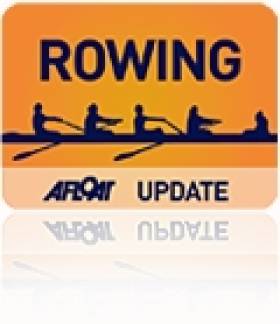Displaying items by tag: CarrickonShannon
Boaters Beware of Diving Operations in Carrick-on-Shannon This Friday
Waterways Ireland is notifying all masters of vessels that diving operations will take place at Carrick-on-Shannon on Friday 18 December.
The locations of the diving operations are 1 along the quay wall some 30 metres downstream and upstream of the bridge, and along the quay wall near the boat club.
Masters of vessels and all inland waterways users are requested to proceed with additional caution in the vicinity of the diving operations.
#Rowing: Portadown Regatta enjoyed almost perfect conditions today. A packed programme was run in bright, warm sunshine and on flat water. RBAI beat the host club in one of the top events of the day, the men’s junior 18 eights final, reversing the decision of last year.
Shauna Murtagh of Carrick-on-Shannon beat Kate Crawford of Portadown in the women’s junior 18 single sculls – a first win in a regatta for the 16-year-old daughter of Ireland great Frances Cryan.
The men’s junior 18 single was won by Hugh Moore of Coleraine Grammar School.
Enniskillen and Coláiste Iognáid Pick up Pennants at Carrick
#Rowing: The Head of the Shannon enjoyed good weather and an appreciative crowd at Carrick-on-Shannon on Saturday. The timing system encountered some difficulties. Neptune’s junior 18 quadruple were the fastest crew in the first head. The pennant for this class was granted in the second head and Enniskillen took it. The Fermanagh club had a set of wins at junior level, as did Coláiste Iognáid of Galway. Commercial’s junior 16 women’s eight also came out on top.
Head of the Shannon, Carrick-on-Shannon, Selected Results (Category winners)
Head One
Men
Eight – Jun 16: Col Iognáid. Masters: Neptune (d)
Four – Jun 18, coxed: Enniskillen
Pair – Sen: Galway. Jun 18: Enniskillen
Sculling
Quadruple – Jun 16, coxed: Sligo. Masters: Galway (e). Masters, coxed: Athlone (e).
Double – Sen: Portadown. Masters: City of Derry (d). Jun 18: Enniskillen
Single – Jun 16: Athlone (Carroll)
Women
Eight – Jun 18: Col Iognáid
Four – Club, coxed: Athlone
Sculling, Quadruple – Jun 18: Enniskillen
Double – Club: Carrick-on-Shannon. Jun 16: Commercial
Single – Club: Carrick-on-Shannon (Early). Jun 18: Enniskillen (Fee)
Head Two
Men
Eight, Jun 18: Portadown
Four – Masters, coxed: Athlone (b)
Sculling
Quadruple – Jun 18: Enniskillen
Double – Club: Enniskillen. Jun 16: Enniskillen
Single – Sen: Sligo (G Patterson). Jun 18: Carrick-on-Shannon (Early). Masters: Athlone (Gallen, f)
Women,
Eight
Club: Galway. Jun 16: Commercial. Masters: Tribesmen B (e)
Four – Jun 18: Col Iognáid.
Pair – Jun 18: Col Iognáid
Sculling
Quadruple – Jun 16, coxed: Sligo.
Double – Jun 18: Enniskillen
Single – Club: Carrick-on-Shannon (T Duggan). Jun 16: Carrick-on-Shannon (Murtagh).
New Angling Developments Launched In Roscommon & Leitrim
#Angling - Denis Naughten, Minister for Communications, Climate Action and Environment, has officially launched two new angling developments by Inland Fisheries Ireland (IFI) at Emlaghroyan in Roscommon and ‘The Mudflats’ at Carrick-on-Shannon in Co Leitrim.
A new match angling stretch has been provided at Emlaghroyan, on the River Suck in Roscommon, with upgraded car parking and drive-to-peg facilities.
This development involved upgrading existing roadways and the construction of new access roadway.
Ten new match angling pegs have been provided, with a capacity for further extension.
The Suck Valley Angling Hub were recently granted additional funds through the National Strategy for Angling Development (NSAD) to extend the match venue to further promote tourism angling and facilitate match competitions in the Roscommon/East Galway area.
Together with recently unveiled developments on the River Suck at Lough Acalla, the total investment in the River Suck project was €87,000.
In Leitrim, another major 2017 development project has been completed with an investment of €103,000, providing new facilities at ‘The Mudflats’ on the main River Shannon at Carrick-on-Shannon.
The new floating angling stand is accompanied by improved roadways and parking, upgraded toilet facilities and a new slipway.
This is another important match angling venue, used widely for international match angling events such as the World Pairs and the Carrick Angling Festival.
Speaking in Carrick-On-Shannon after the ribbon-cutting ceremony yesterday (Friday 1 December), Minister Naughten said: “I am delighted to mark the official opening of these developments today. Both were completed under the National Strategy for Angling Development (NSAD) and greatly enhance the angling infrastructure in both counties. They will provide a boost to angling tourism potential in the region, which in turn should increase visitor numbers.
“Furthermore, these projects would not be possible without the cooperation, agreement and vision of the respective landowners and I would like to thank all those involved for their contribution to these developments.”
More applications from the region are currently going through the NSAD assessment process, and aim to enhance the angling infrastructure in the upper Shannon areas as well as promote participation in angling.
Two weeks ago Minister Naughten unveiled new angling infrastructure in Galway and Athlone, as previously reported on Afloat.ie.
Bodies Of Couple Recovered From Carrick-on-Shannon Marina
#Shannon - RTÉ News reports that the bodies of a man and a woman were recovered from the water at a marina in Carrick-on-Shannon yesterday afternoon (Friday 31 March) just hours after they were reported missing.
The couple, an Irish man and an English woman living in Germany, had been boating in the area since the beginning of the week, and were last seen at a restaurant near the Co Leitrim town’s marina on Wednesday night (29 March). The deaths are being treated as accidental.
#Rowing - The Carrick-on-Shannon Rowing Regatta will be held on Sunday 31 July on a 400m stretch of the waterway immediately south of the town bridge.
Hundreds of spectators and competitors are expected at the event, one of the final rowing events of the season, which is supported by Waterways Ireland through its sponsorship programme.
Events begin at 8am and will run till around 6pm. Craft wishing to make a through passage will be facilitated every two hours (approx) during the course of the regatta. Mooring restrictions will apply in Carrick-on-Shannon to facilitate the regatta.
In the interest of marine safety and to facilitate the laying of the competition course, access to the floating moorings will be restricted in the run-up to and during the event itself.
Only vessels of an overall length of 22ft/6.8m or less will be permitted on the floating jetties from Friday 29 to Sunday 31 July. Vessels berthed from Friday 29 July at 4pm will be required to remain in place until racing finishes on the Sunday evening.
The floating jetties will be closed off during this time and no vessels should approach as the entrance to the berths will be closed off and manoeuvring room will be severely restricted due to the proximity of the course. Access to the floating jetties will be monitored from Monday 25 July.
Masters are advised to proceed at slow speed and with due caution and to take note of advice from course marshals when passing through the area.
Further information can be had by contacting the Waterways Ireland inspectorate at +353 (0)87 985 2324 or North Shannon operations at +353 (0)71 96 50787.
Head of the Shannon Cancelled Because of Rising Water Levels
#Rowing: The Head of the Shannon, fixed for Carrick-on-Shannon this Saturday, December 5th, has been cancelled. The organisers say that the rising water levels on the river, combined with the forecast for the weekend, has left them with no alternative. The Muckross Head is also scheduled for Saturday, at the National Rowing Centre in Cork.
#InlandWaterways - Waterways Ireland has advised all masters and users of the Erne system that the channel east of Castle Island near Enniskillen will be closed till Tuesday 11 June to facilitate a number of events on the water.
Mariners are directed to follow the marked navigation channel and signs to the west of Castle Island and proceed at a slow speed and with minimum wash. They should note any advise or instructions given by event organisers when in this section of the navigation.
Public jetties in the vicinity will remain accessible throughout, though some minor restrictions may be in place as and when required. Further information is available from the Lough Erne warden at 028 6632 3004.
Elsewhere, there will also be restricted mooring for masters and owners on the River Shannon at Carrick-on-Shannon to facilitate spectator viewing of the Carrick 400 event.
On Sunday 2 June the quay wall from the downstream face of the town bridge to the floating moorings will be out of bounds for mooring from 7pm till midnight.
In other waterways news, recent water quality testing has shown the harbour at Kilcock on the Royal Canal to now be within normal bathing water standards.
Trinity Rowers Fastest at Carrick Head of the River
# ROWING: Trinity’s intermediate eight were the fastest crew in the first head at the Carrick-on-Shannon Head of the River today. They had almost eight seconds to spare over the second-placed NUIG intermediate eight.
CARRICK-ON-SHANNON HEAD, SATURDAY| 1 | Dublin University BC | mens intermediate 8+ | 12:48.6 | 24:23.5 | 11:34.9 | ||
|---|---|---|---|---|---|---|---|
| 2 | NUI Galway BC | mens intermediate 8+ | 13:12.9 | 24:55.6 | 11:42.7 | ||
| 6 | St. Josephs College RC | mens intermediate 8+ | 15:21.5 | 27:25.4 | 12:03.9 | ||
| 5 | Dublin University BC C | mens intermediate 8+ | 15:01.9 | 27:36.6 | 12:34.7 | ||
| 26 | Bann RC | mens J16 8+ | 28:55.4 | 41:38.9 | 12:43.5 | ||
| 3 | NUI Galway BC | mens senior 4- | 13:42.0 | 26:31.0 | 12:48.9 | ||
| 7 | Dublin University BC D | mens intermediate 8+ | 16:05.1 | 29:00.2 | 12:55.1 | ||
| 27 | Colaiste Iognaid RC | mens J16 8+ | 29:42.0 | 42:49.6 | 13:07.6 | ||
| 4 | Dublin University BC | mens senior 4- | 14:04.9 | 27:25.8 | 13:21.0 | ||
| 38 | Commercial RC | mens J16 4X+ | 36:05.5 | 49:31.5 | 13:25.9 | ||
| 12 | Athlone BC - Athlone BC/City of Derry BC (e 457) | mens masters 8+ | 19:13.7 | 32:43.0 | 12:16.3 | 13:29.3 | |
| 30 | NUI Galway BC | mens novice 4+ | 31:49.2 | 45:34.0 | 13:44.8 | ||
| 9 | Colaiste Iognaid RC | mens J18A 4+ | 18:10.4 | 32:00.8 | 13:50.4 | ||
| 28 | St. Josephs College RC | mens J16 8+ | 30:15.9 | 44:10.4 | 13:54.5 | ||
| 13 | Lady Victoria BC (f 486) | mens masters 8+ | 19:37.1 | 33:56.4 | 12:40.3 | 14:19.3 | |
| 25 | Athlone BC | mens J16 8+ | 28:21.2 | 42:45.2 | 14:24.0 | ||
| 15 | Athlone BC | mens J18A 2X | 20:52.7 | 35:21.2 | 14:28.4 | ||
| 18 | Bann RC | mens senior 2- | 23:16.7 | 37:45.3 | 14:28.6 | ||
| 31 | Dublin University BC | mens novice 4+ | 32:30.4 | 47:03.8 | 14:33.3 | ||
| 14 | Commercial RC | mens J18A 2X | 20:15.2 | 34:49.5 | 14:34.3 | ||
| 34 | Commercial RC | womens intermediate 4+ | 34:09.0 | 48:49.7 | 14:40.8 | ||
| 37 | NUI Galway BC | womens intermediate 2X | 35:34.4 | 50:19.8 | 14:45.4 | ||
| 52 | Dublin University BC B (Jacques) | mens intermediate 1X | 42:14.7 | 57:01.3 | 14:46.6 | ||
| 51 | Commercial RC B (Yeomans) | mens intermediate 1X | 41:36.1 | 56:26.6 | 14:50.6 | ||
| 56 | Dublin University BC D (Acheson) | mens intermediate 1X | 43:46.9 | 58:38.8 | 14:51.9 | ||
| 50 | Three Castles Rowing Club (Corcoran) | mens intermediate 1X | 41:08.1 | 56:00.3 | 14:52.3 | ||
| 33 | NUI Galway BC | womens intermediate 4+ | 33:39.6 | 48:37.1 | 14:57.5 | ||
| 20 | Commercial RC | mens senior 2- | 24:16.0 | 39:15.8 | 14:59.8 | ||
| 21 | Commercial RC B | mens senior 2- | 24:53.5 | 39:55.7 | 15:02.2 | ||
| 58 | Dublin University BC E (Hughes) | mens intermediate 1X | 44:33.1 | 59:45.7 | 15:12.6 | ||
| 32 | NUI Galway BC B | mens novice 4+ | 33:13.2 | 48:27.9 | 15:14.7 | Boat tipped | |
| 35 | NUI Galway BC B | womens intermediate 4+ | 34:36.4 | 49:53.0 | 15:16.7 | ||
| 44 | Carrick-on-Shannon RC B (Leyden) | mens intermediate 1X | 38:49.8 | 54:10.9 | 15:21.1 | ||
| 23 | Commercial RC | womens J18A 4X- | 26:08.0 | 41:30.8 | 15:22.7 | ||
| 77 | Commercial RC | mens J15 2X | 51:02.9 | 06:30.0 | 15:27.1 | ||
| 16 | Colaiste Iognaid RC | mens J18A 2X | 21:39.6 | 37:10.8 | 15:31.2 | ||
| 48 | Carrick-on-Shannon RC A (Cox) | mens intermediate 1X | 40:10.5 | 55:41.7 | 15:31.2 | ||
| 8 | St. Josephs College RC | mens J18A 2X | 22:16.1 | 37:47.7 | 15:31.7 | ||
| 17 | Commercial RC B | mens J18A 2X | 22:57.1 | 38:33.6 | 15:36.5 | ||
| 40 | Commercial RC | womens novice 8+ | 37:21.3 | 52:59.1 | 15:37.9 | ||
| 22 | Colaiste Iognaid RC | womens J18A 4X- | 25:20.7 | 40:59.1 | 15:38.4 | ||
| 39 | Sligo RC | mens J16 4X+ | 36:41.8 | 52:27.7 | 15:45.9 | ||
| 55 | Commercial RC D (Carroll) | mens intermediate 1X | 43:21.8 | 59:11.5 | 15:49.7 | ||
| 64 | Carrick-on-Shannon RC (Carthy) | mens J18A 1x | 46:25.9 | 02:15.6 | 15:49.7 | ||
| 47 | Bann RC (Whoriskey) | mens intermediate 1X | 39:40.9 | 55:32.9 | 15:52.0 | ||
| 60 | Dublin University BC G (Pounch) | mens intermediate 1X | 45:21.9 | 01:22.1 | 16:00.2 | ||
| 61 | Athlone BC | mens J15 4X+ | 45:54.2 | 01:55.7 | 16:01.5 | ||
| 75 | Lagan Scullers Club B (b 79) | mens masters 2X | 50:09.5 | 06:11.9 | 15:54.3 | 16:02.3 | |
| 24 | Athlone BC | womens J18A 4X- | 26:49.3 | 42:55.3 | 16:06.0 | ||
| 122 | St. Michaels Rowing Club (e 230) | mens masters 4+ | 27:18.7 | 43:32.7 | 14:55.0 | 16:14.0 | |
| 72 | Carrick-on-Shannon RC | womens J16 2X | 48:51.8 | 05:08.8 | 16:17.0 | ||
| 57 | Commercial RC E (D'Estelle-Roe) | mens intermediate 1X | 44:08.0 | 00:28.9 | 16:20.9 | ||
| 59 | Dublin University BC F (Mc Cormick) | mens intermediate 1X | 44:55.2 | 01:17.7 | 16:22.4 | ||
| 67 | Carrick-on-Shannon RC A (Hartigan) | mens J16 1X | 47:39.0 | 04:08.7 | 16:29.7 | ||
| 41 | NUI Galway BC | womens novice 8+ | 38:10.7 | 54:55.3 | 16:44.6 | ||
| 73 | Colaiste Iognaid RC | womens J16 2X | 49:12.4 | 05:57.6 | 16:45.2 | ||
| 65 | Carrick-on-Shannon RC (Kelly) | womens J18A 1X | 46:49.8 | 03:43.0 | 16:53.3 | ||
| 29 | St. Josephs College RC B | mens J16 8+ | 31:08.3 | 48:14.5 | 17:06.2 | ||
| 49 | Belfast BC (Lockwood) | mens intermediate 1X | 40:35.1 | 57:46.3 | 17:11.2 | ||
| 46 | Athlone BC (Molloy) | mens intermediate 1X | 39:16.4 | 56:40.8 | 17:24.4 | ||
| 177 | Athlone BC | womens J15 2X | 53:03.3 | 10:48.0 | 17:44.7 | ||
| 69 | Commercial RC B (O Rourke) | mens J16 1X | 48:06.5 | 05:57.1 | 17:50.6 | ||
| 74 | Sligo RC | womens J16 2X | 49:42.7 | 07:36.6 | 17:53.8 | ||
| 54 | Dublin University BC C (Dolan) | mens intermediate 1X | 43:04.7 | 01:10.7 | 18:06.0 | ||
| 70 | Carrick-on-Shannon RC B (Jordan) | mens J16 1X | 48:27.4 | 06:45.8 | 18:18.4 | ||
| 76 | Lagan Scullers Club A - Belfast RC/Lagan Scullers Club (h 146) | mens masters 2X | 50:39.5 | 09:00.6 | 14:55.1 | 18:21.1 | |
| 66 | Commercial RC A (Byrne) | mens J16 1X | 47:21.0 | 05:46.9 | 18:25.9 | ||
| 10 | Dublin University BC | mens senior 2X | 18:21.2 | 37:01.2 | 18:40.0 | ||
| 163 | Garda Siochana BC | womens novice 4+ | 52:42.6 | 11:23.0 | 18:40.4 | ||
| 80 | Belfast BC (Lockwood) (f 62) | womens masters 1X | 51:53.4 | 10:52.1 | 16:34.7 | 18:58.7 | Time Only |
| 78 | Carrick-on-Shannon RC (Brogan) | womens J15 1X | 51:27.1 | 10:44.8 | 19:17.7 |
Carrick Prepares for Big Rowing Influx
ROWING: Carrick Rowing Club are delighted that more than 100 crews have entered the Apollo Duck Head of the Shannon in Carrick on Shannon on Saturday, February 18th. There will be two time trial events on the day with crews racing over a 5km stretch of river from south of Carrick back into town. The finish line and viewing area is situated at the boardwalk where crews will be seen going hard for the last few hundred metres.
The entry features a great representation from Ulster: Bann, Belfast Rowing Club, Belfast Boat Club, Lagan Scullers, City of Derry and Lady Victoria. Portora Club from Enniskillen are also travelling the shorter distance, as are Sligo Rowing Club. Athlone Rowing Club have entered lots of crews, from Junior 15 boys and girls right through to masters rowers.
From Galway, Tribesmen Rowing Club and St. Joseph’s School are set to travel with many up-and-coming rowers. Commercial, Three Castles and Garda Siochana travel from the east of the country.
The influx will provide a welcome boost to the local economy at a time when things are generally quiet. Details can be found at the event website www.HeadoftheShannon.com while the club welcomes any offers of help on the day.


























